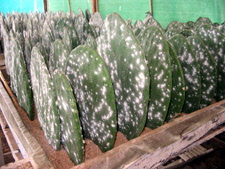The Veria Network’s Under The Sun Series
Review of the Oaxaca, Mexico, Episodes: Episode 1
An international documentary film production company was drawn to the central valleys of the State of Oaxaca while investigating regions of the world where sustainable living still plays a major role in the way people live. After a preliminary visit to the state capital to scope out the feasibility of story lines, its production team ultimately shot two, five-segment episodes in the heart of Oaxaca.
The mandate of The Veria Network’s cable TV series Under the Sun is to capture a broad diversity of locales, organizations and individuals involved in healthy, harmonious, holistic, and environmentally friendly living and business enterprises. Each episode features British born Nathan LeRoy, a self-proclaimed adventurer, investigating how age-old means of production persist into the 21st century, and examining sustainable systems and products. This is done with a not-so-subtle underscore: maintaining and promoting unity with the natural world provides humankind the best opportunity to survive and thrive for generations to come.
EPISODE ONE
LeRoy accompanies internationally acclaimed native Oaxacan chef Pilar Cabrera Arroyo (Bon Appetit, The New York Times, Toronto Iron Chef judge & competitor) to Oaxaca’s Pochote Organic Market. An interesting discussion ensues as to the certification process in respect to organic products. LeRoy propounds that forcing growers to leap through hoops in attempting to obtain certification is actually inconsistent with supporting small- scale local production. He then accompanies Chef Pilar to her Casa de los Sabores (House of Flavors) Cooking School for a lesson in preparing three dishes – an organic salad with a honey mustard garlic dressing; world famous mole negro, the most labor intensive of the many moles, traditionally made with approximately 35 ingredients; and a delightfully fresh and uniquely flavorful organic rose petal sorbet.
Our adventurer then meets up with a family of San Mart√≠n Tilcajete wood carvers and painters, headed by Jacobo √Āngeles and Mar√≠a Mendoza. His goal is to learn about the town’s longstanding Zapotec woodcarving tradition. While trekking through the countryside he and Jacobo discuss the properties and uses of the copal tree from which most figures – known as alebrijes – are carved. Leroy then explores the use of natural pigments for coloring the pieces; Mar√≠a deftly uses her hands as palettes as she variously mixes tree sap and bark, honey, pomegranate, corn fungus, berries and other natural substances to create a veritable rainbow of paint colors.
Next he receives a lesson from a triumvirate of absolutely charming apron-clad abuelitas (little grandmothers) on how to make three refreshing drinks, each of which is typical to the region and commonly found in both urban and rural Oaxacan markets: agua de Jamaica (juice or water of hibiscus flower), agua de lim√≥n (a natural limeade made with the outer peel), and the uniquely indigenous pre-Hispanic drink, tejate. Making tejate is a true art, and highly ritualistic. If a step in the process goes awry, the end result simply won’t cut it. Being the Drink of the Gods in pre-Hispanic times, process must be perfect.
Leroy then gets out into the fields just after dawn one morning, with a woman whose family has been making the naturally fermented drink known as pulque, for generations. Pulque is perhaps the single least understood drink in Mexico, at times mistakenly noted as the first stage in the production of mezcal and tequila. The plant, one of several pulquero varieties of agave or maguey, must mature in the field for 15 – 18 years before it yields aguamiel or honey water. At sunrise and sunset the liquid is religiously harvested from a deep well in the center of the plant. Natural fermentation of the aguamiel occurs over the course of just a few hours. Be it myth or science-based, the indigenous guide counsels as to pulque’s curative and life-prolonging properties.
|
Cochineal is still used to dye Campari and Campbell soup
|
In the final segment of the episode LeRoy learns about cochineal ( cochinilla ), the minute insect which feeds off of the nopal cactus. Cochineal has been commercially cultivated, harvested and exported since early colonial times because of its unique property – it yields a strong, natural red dye which to this day is used in the production of such diverse products as Campari, Knorr and Campbell soups, lipsticks and make-ups, Danone yoghurt, hot dogs and cookies. Manuel, the engineer / manager of the museum and educational facility known as Tlapanochestli, explains the historical importance of the cochineal industry while going through the lifecycle of the insect and production technique currently employed. Experimentation into the use of other natural dyes and fibers continues at the research station.
Alvin Starkman has a Masters in Anthropology and a law degree from Osgoode Hall Law School. Alvin began traveling to Oaxaca in 1991, taking up permanent residence in 2004. He has written over 90 articles about life and culture in Oaxaca for several Mexico travel publications. Alvin consuls to documentary film production companies working in the region, and leads personalized tours for couples and families to the craft villages, market towns, ruins and more off-the-beaten-track locations rarely visited by tourists. He and his wife Arlene operate Casa Machaya Oaxaca Bed & Breakfast (http://www.oaxacadream.com), a bed and breakfast experience combining comfort of a downtown Oaxaca hotel, with the personal touch of country inn accommodations.



